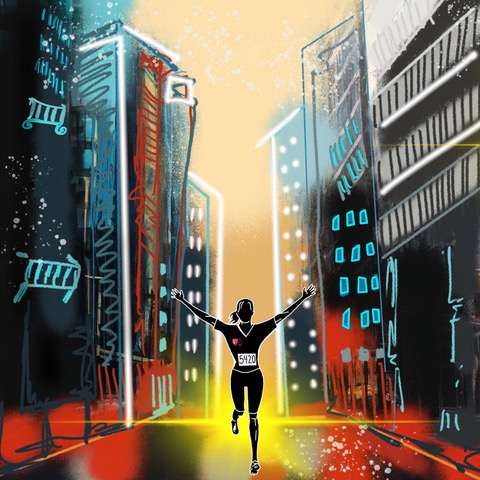By Nicklas Balboa
Published in: Psychology Today
There and back again, a nurse’s journey from uncontrolled to controlled chaos.
Handling the impact of trauma is not new business for Stanford Pediatric Emergency Department nurse Daugherty Werner. However, understanding the many factors that make individual reactions to trauma unique takes a lifetime of hands-on experience, and that’s exactly what she has. Hailing from Louisville, Kentucky, Daugherty is one of seven children born to loving parents Julia, the stay-at-home mother, and Jerry, the bourbon distilling father. Though life in Derby City did not last long, by the time she turned 13, the family moved to the quaint and small town of Bardstown, Kentucky, bourbon capital of the world.
Author Edward Fallon wrote, “Sometimes you find yourself in the middle of nowhere, and sometimes, in the middle nowhere you find yourself." Perhaps the move from a big city to a small town is what inspired Daugherty’s penchant for travel. She has known for many years that nursing is her calling, but it wasn’t until her 29th birthday that Daugherty completed an associate degree in nursing and began working as an emergency room nurse at the University of Kentucky Hospital. “When you see four to six patients at a time, it’s important to manage all of the movement with autonomy and proper prioritization. You must ask yourself what your first action is and remain aware of what is salient,” says Daugherty, speaking about her time in the ER. “Your decisions matter, and your ability to respond to the present context not only depends on how well you understand the medicine, but also how well you can navigate the patient’s narrative.”
In the ER it’s life and death, so there are going to be some tough decisions. It’s important to move efficiently and with precision, especially when you’re walking five to six miles in a single shift. However, a good nurse knows not to let their expert knowledge lead their patients. By listening to connect, Daugherty learned how to master the art within the science and better connect with her patients through meaningful conversations. “Sometimes it’s a lot of filtering, but when you take the extra time to listen and ask discovery questions, you can paint a more complete picture of the patient, the whole person,” says Daugherty. It’s this holistic approach that led her to the neurosurgery ICU, where she could begin to answer the question: “What’s happening to my patients when they leave the ER?”
For the next six years she floated between ERs and ICUs at the University of Kentucky, Stanford University, and the University of Colorado. Her time spent in intensive care units and in the field helped nurse Daugherty uncover the bigger picture of patient care. From individual trauma care to empathetic conversations with patient families to critical ground care, the transition from uncontrolled to controlled chaos unlocked a new perspective, blurring the lines between the hospital and the outside world. It was during this time that Daugherty realized the impact of being a first responder, noting that, “You don’t realize, until you step into someone’s home, that the energy from the trauma is still present.” It is intimate life experiences like these that add to the ‘clinical intuition bank’ and allow healthcare practitioners to increase their sensitivity, develop emotional skills, and better empathize with patients. However, with increased empathy sometimes comes burnout.
In search of a break from the stress and intensity of level 1 trauma, she took a step back and took a position as an MRI sedation nurse. It was during this downtime that she was able to reflect on her career and consider her next move. “I knew that I missed the pace of the ER and ICU, but I also felt a deep desire to push beyond my comfort zone, and for me, that was transitioning to the pediatric intensive care unit (PICU) at University of Kentucky. I asked myself what area of nursing I considered myself lacking in expertise, and it was pediatric nursing,” says Daugherty. For some, knowing what you can improve upon is just half the story; it’s what you do about it that counts.
Daugherty took that PICU knowledge and joined the Stanford Pediatric Emergency Department in 2010, and has been a part of a tight knit, cohesive team. Through thick and thin, this team rides the emotional highs and lows together, often decompressing with a cry or a laugh, sometimes both. She credits her peers with helping her grow and develop as a pediatric nurse, a daunting challenge if faced alone. As she developed trust and understanding with fellow team members, her perspective on pediatric medicine matured.
“Working with children is an amazing experience because they are so honest and resilient. And every child comes with a caregiver, so it’s important to communicate with them as well and try to give them some control,” says Daugherty. “Some parents want to hold their child during a procedure, and others want to take a break and leave the room. Communicating in a non-judgmental way and recognizing the fear that can be present goes a long way.”
When she’s not keeping pace with the influx of patients, Daugherty likes to stay busy on the roads, long-distance running. By the time she had a few 5Ks and half marathons under the belt, life took her down a different route. 2015 proved to be a difficult year, coupling neck surgery with the loss of her mother to a long battle with cancer, leaving her father in need of attentive care. It appeared as if she needed to be two places at once, pitting two of her loves against one another: nursing at Stanford, and the call to support her family and father.
Born under a lucky star, Daugherty and the hospital’s management were able to come up with a plan that fulfilled both of her loves. She began commuting from Kentucky to California, working six 12-hour shifts consecutively, then returning home for 20 days to help care for her father. Again, it was during this downtime that she set another goal: completing a marathon. Just two years after recovering from neck surgery, she completed a world-class marathon (Chicago) in 5 hours and 36 minutes. Just one week later, she completed the Urban Bourbon Half Marathon with her sisters. It’s the kind of story that one might ride off into the sunset with, but life works in peculiar ways, and sometimes you just don’t know what’s going to happen next.
When the pandemic hit, Daugherty was again faced with a difficult decision, one that would require a permanent choice, at least for the immediate future. With a mandatory 2-week quarantine in place for travelers to Kentucky, she knew that maintaining her work schedule meant leaving home for the foreseeable future. And on the drop of a dime, she packed her truck with her dogs and belongings, en route back to the Bay Area; Stanford Pediatrics ED was waiting.
What she did not know was that, other than the virulent virus, there was another surprise waiting for her in California. In March, Daugherty was voted Stanford’s 2020 Pediatric Emergency Department Nurse of the Year by her peers. She did not see this honor coming, and was very humbled. This award helped her to recognize that all the hard work and sacrifices were, in fact, noticed. “I know my mom is so very proud of me,” says Daugherty.









